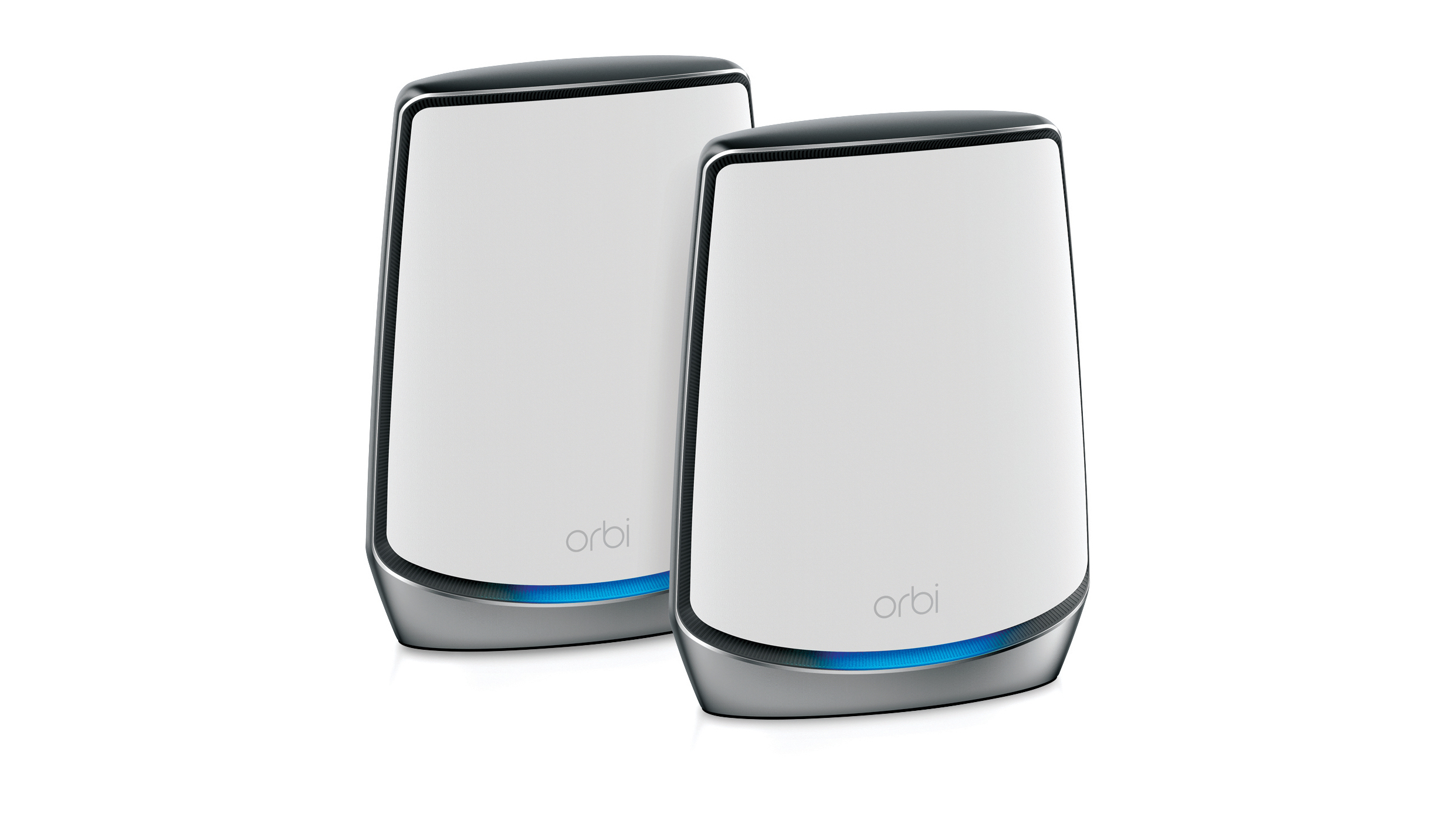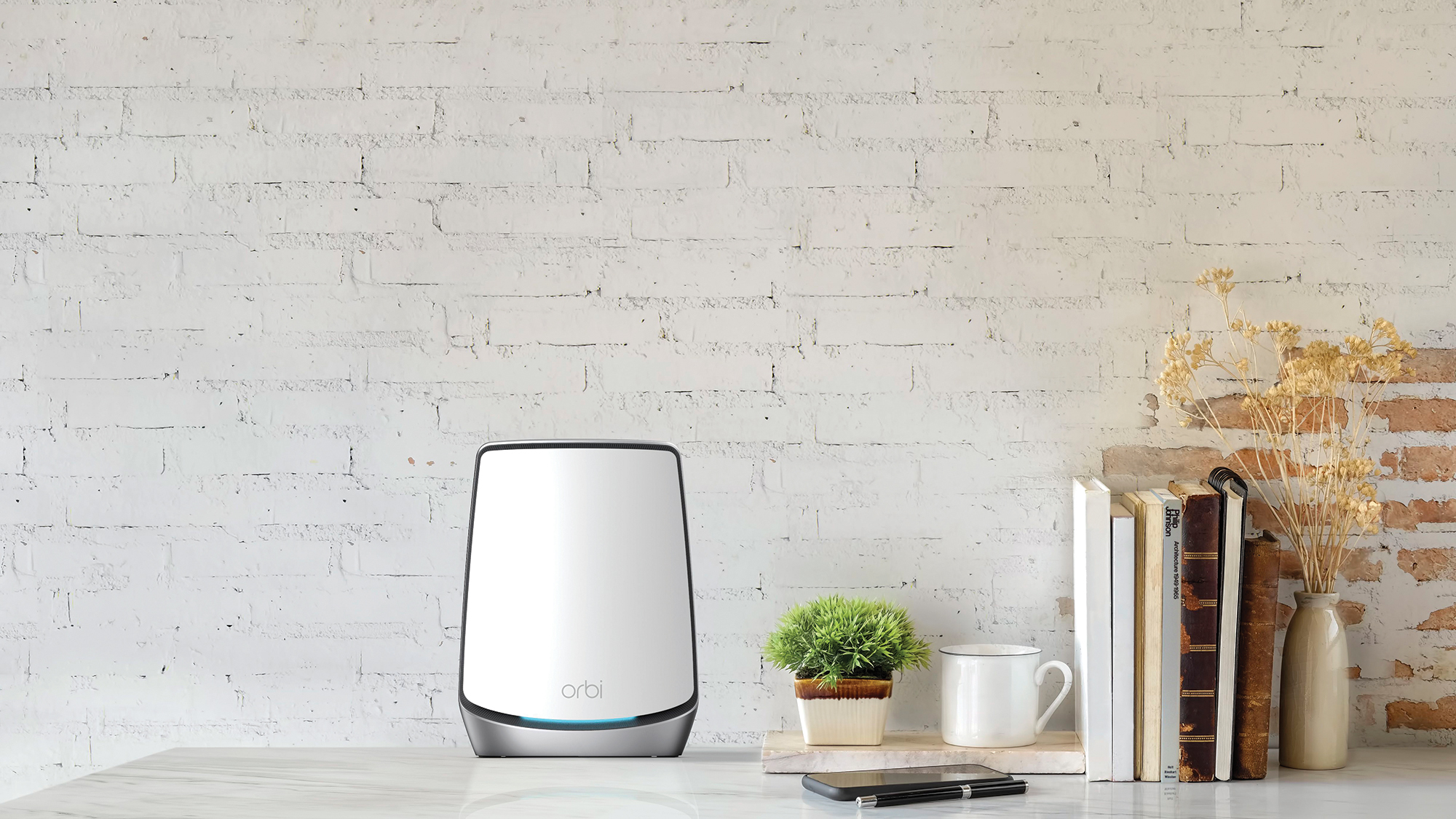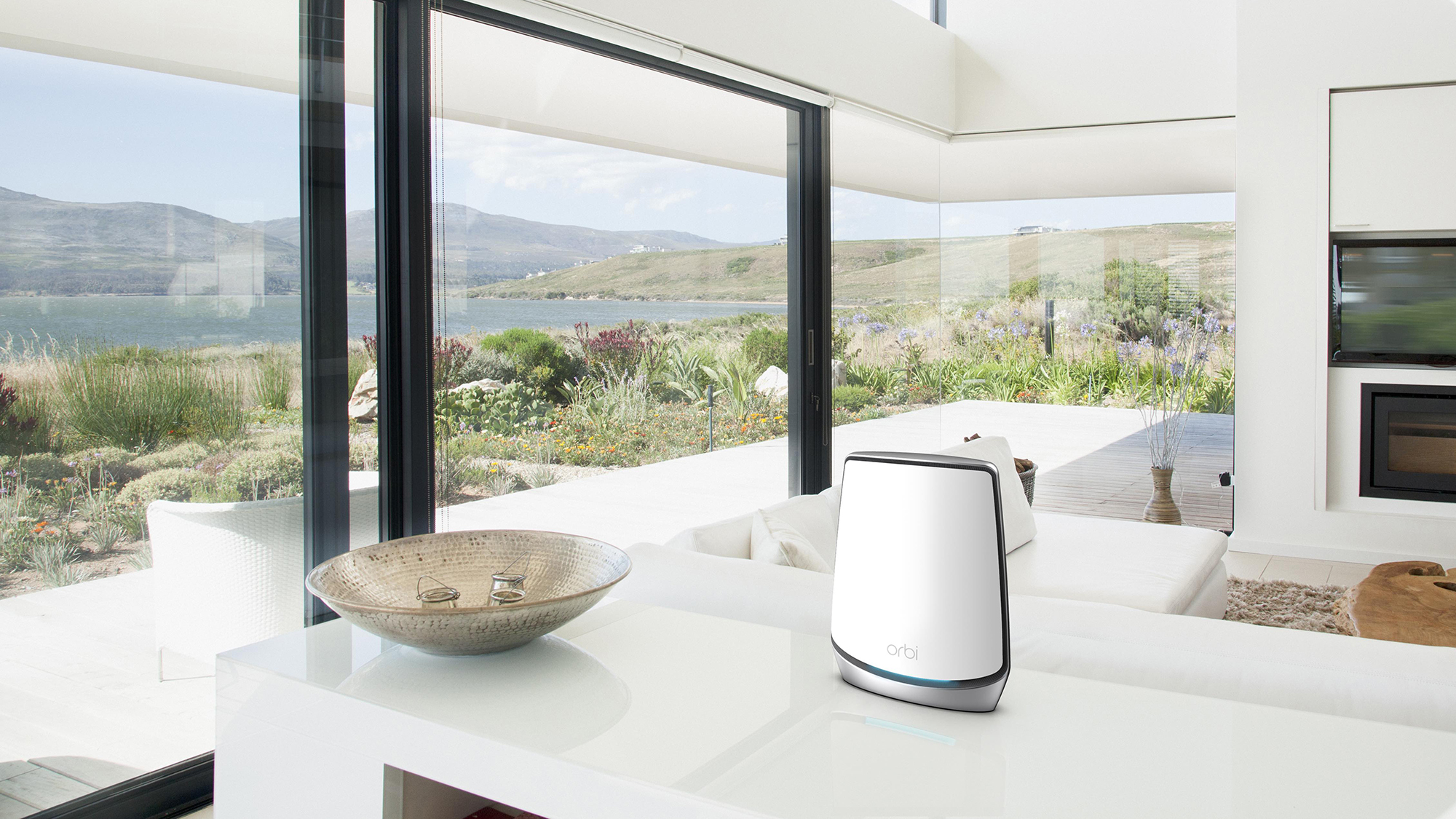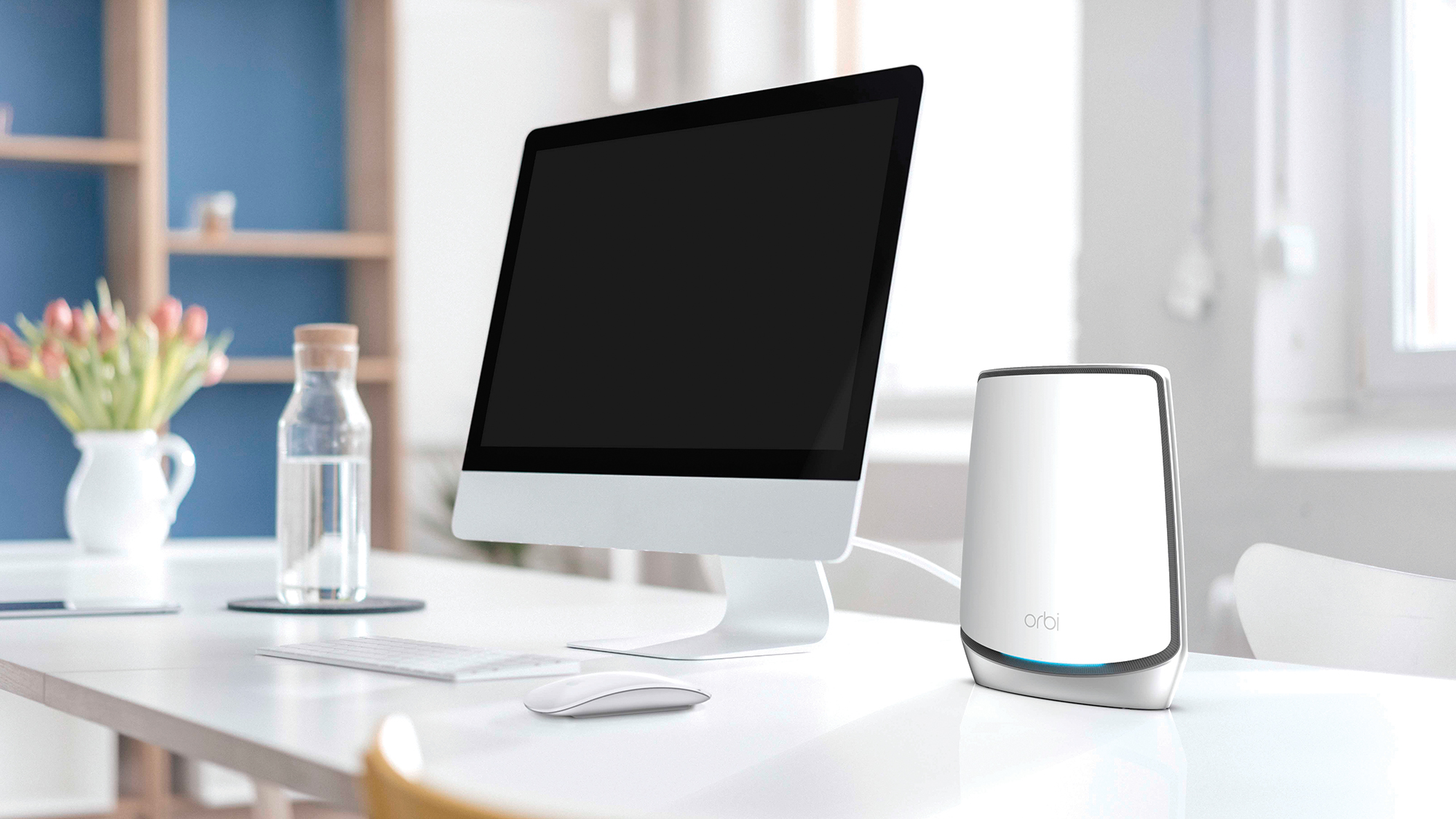Netgear Orbi WiFi 6 review: Outstanding, but possibly overkill
The first 802.11ax mesh system leaves its rivals in the dust – but does anyone actually need it?


-
+
Amazing speeds
-
+
Great coverage
-
+
Smart setup
-
-
Expensive

There are plenty of mesh networking systems on sale, but until now they’ve all relied on 802.11ac Wi-Fi, rather than taking advantage of the newer, faster 802.11ax (or Wi-Fi 6) standard. In its defence, 802.11ac works perfectly well for most purposes, including 4K video streaming – but 802.11ax is designed to cope better with ever-increasing numbers of connected clients, and has the performance headroom to handle any bandwidth-hungry technologies we’ll be using in a few years. Perhaps, then, it’s time to think about an infrastructure upgrade.
Enter the Orbi WiFi 6, the world’s first 802.11ax mesh system. The idea of serving up ultra-fast, next-generation Wi-Fi to every corner of your building is seductive, but it comes at a steep price. Let’s see if the cost is justified.
The Orbi WiFi 6 is a tri-band wireless mesh system supporting 802.11ax connections on both 2.4GHz and 5GHz bands, with a separate 5GHz radio dedicated to backhaul traffic. Each unit houses eight antennae and supports 4x4 MU-MIMO; Netgear claims maximum connection speeds of 1,200Mbits/sec on the 2.4GHz band and 2,400Mbits/sec over each of the 5GHz bands. To get the best performance you’ll naturally need an 802.11ax-enabled client, but the Orbi also works with older devices using 802.11ac or 802.11n.
The standard pack includes two units – one dedicated router and one satellite – with a claimed total coverage of up to 465m2. As it’s a mesh system, you can add extra satellites to extend your wireless reach, although the Wi-Fi 6 units won’t interoperate with nodes from older Orbi kits. The expectation is that the Orbi will replace your existing router, but it can also be switched into access point mode to provide upgraded wireless services for a separate router.
Netgear Orbi WiFi 6 review: Design
The Orbi units look all but identical to one another, but (unlike some mesh systems) they’re not interchangeable, with one designated as the router and the other as a satellite. They’re of a similar size and shape to their 802.11ac forebears, standing 254mm tall with an oval 71 x 191mm footprint, which makes them an imposing presence on your shelf or coffee table.

To distinguish the new models from the old, Netgear has added a black trim with brushed silver edging; to our eyes this makes them look like something from the Starship Enterprise, which you might love or hate. A more practical change is the addition of a pair of screw-holes in the bottom of each unit, allowing you to mount the nodes on a ceiling or wall.
There’s no display, but a downward-facing LED array in the front of each unit occasionally lights up and illuminates whatever surface it’s been placed on, glowing white when booting up or moody magenta if there’s a connection problem. A tiny secondary LED at the back shows when the unit’s powered and turns red if there’s a firmware error.
While the Orbi’s focus is obviously on Wi-Fi, we’re pleased to see that, as on the older units, each station has four rear Gigabit Ethernet sockets. With the rise of smart home hubs and the continued popularity of NAS appliances, wired networking is if anything more prevalent than it was five years ago, and it’s frustrating when mesh systems offer only one or two sockets.
The router unit also sports a fifth Ethernet socket for your internet connection. This supports both Gigabit and 2.5GbE speeds, or can be combined with the first LAN socket for an aggregated 2Gbits/sec connection. We doubt many customers will take advantage of these high-speed options, but knowing they’re there goes a little way towards assuaging the agonising price.
The only thing that’s notably missing from the Orbi is any sort of USB connectivity: this is normal for mesh systems, but it’s not unreasonable to hope that a high-end system like this would offer an easy way of sharing external storage or a printer over the LAN.
Netgear Orbi WiFi 6 review: Setup and software
The Orbi WiFi 6 can be set up using either Netgear’s Orbi mobile app or a web-based wizard. We chose the latter, which automatically detected and set up our internet connection, tested the signal strength between the two nodes, prompted us to set a secure administrative password and installed the latest firmware on both nodes. The whole process took less than five minutes and only a few clicks.

Once you’re up and running, you can return to the web portal at any time to monitor and manage your Orbi system. If you’ve used a Netgear router before there are no surprises: the interface is divided conveniently into Basic and Advanced settings, and all the expected options are present, allowing you to tweak your IP and DHCP settings, adjust your wireless configuration, bind IP addresses to specific clients, set up port forwarding and enable the guest network.
One neat feature is a built-in VPN service; you can use this to securely “dial into” your home network from anywhere in the world, using the free OpenVPN client for Windows, macOS, Android and iOS. You can even give your Orbi router an easy-to-remember external address, from a choice of dynamic DNS providers. Sadly, as usual with Netgear, there’s no option to route your domestic internet traffic through a third-party VPN service.
Parental control provisions are very limited. The original Orbi system integrated with the Disney-branded Circle platform, providing category-based filtering and monitoring for free, plus a range of optional paid-for extras such as device-specific time limits. Here, though, there are merely a few manual access settings: you can block websites containing specific keywords, and shut off individual ports and services, but category-based filtering isn’t supported at all. And while the scheduling feature lets you set start and end times for restrictions, there’s only one global timetable, and you can’t vary it on different days of the week.
We’re not blown away by the Traffic Meter feature, either. This tallies up your total internet usage over a specified period, but doesn’t break it down by client, making it more or less useless for working out what’s gobbling up your bandwidth. And weirdly, the QoS Setup page in the web portal only contains an internet speed test tool: hopefully a future update will add proper traffic prioritisation controls.
If you find the web interface daunting, it’s also possible to manage some settings via the Orbi smartphone app. This is less powerful than the web portal, but it lets you configure the guest network, browse connected clients from your phone (and suspend any you don’t recognise) and test your internet speed. It also includes a useful Wi-Fi Analytics module, which lets you monitor the airwaves to see whether your Wi-Fi network is using the best channel, and test the wireless signal as you wander around your home – a big help when it comes to identifying any “not-spots” or areas of poor coverage.
Finally, the Orbi also integrates with both Alexa and the Google Assistant, enabling you to carry out a few specific tasks via voice control. You probably won’t use this every day, but it’s handy to be able to reboot the router and turn the guest network on and off without having to delve into the app.

Netgear Orbi WiFi 6 review: Performance
The big draw of the Orbi WiFi 6 is, of course, its speed. As we’ve mentioned, though, it’s currently the only 802.11ax mesh system on the market, so it’s impossible to truly compare like with like. What we can do is see how it measures up it to the other mesh options you can buy today.
We did this in our usual way, by setting up the Orbi WiFi 6 system as recommended, then measuring transfer speeds to and from a NAS appliance (connected directly to the router unit via Ethernet) from various locations in the building. To get an all-round picture, we used two laptops: our trusty first-gen Surface Laptop with its built-in Marvell 802.11ac adapter, and a Dell Latitude 5490 with a whizzy Intel 802.11ax card.
Unsurprisingly, when you connect to the Orbi WiFi 6 from an 802.11ax-capable laptop, you get performance that 802.11ac-only mesh systems can’t match. No matter where we wandered, the Orbi’s download speeds proved around 80% faster than the nearest last-generation mesh system.
Perhaps more excitingly, the Orbi WiFi 6 can give you a boost even if you’re connecting from an 802.11ac client. That’s because the nodes use 802.11ax to talk to each other, so you get the benefit of a faster backhaul connection. Thus the Orbi WiFi 6 outpaced Linksys, Zyxel and older Orbi systems in every test, and gave us faster downloads than the BT system too, topping just over 60MB/sec download speeds and 39.4MB/sec upload speeds. It couldn’t quite match the Google Nest Wi-Fi for same-room connections, but as soon as we stepped out of the living room the positions were reversed and the Orbi WiFi 6 came out decisively on top.
From a performance perspective, therefore, there’s no doubt: this is the best mesh system on the market. However, if you’re making the leap to 802.11ax, it’s worth questioning whether you actually need a mesh system at all. We’ve found that a standalone 802.11ax router can often convey a good signal to places where 802.11ac struggles, which means you might get the coverage you want without the need for a domestic extender.
The conclusion of our testing is clear: in our standard test scenarios, the mesh system didn’t deliver a persuasive performance advantage over a self-contained router. The Orbi’s dual-node topology did yield a measurable benefit in tough-to-reach rooms, but in all other locations we saw better speeds from the Asus RT-AX88U.

It was a similar story over 802.11ac: here the Orbi WiFi 6 beat the Asus, but couldn’t match the download speeds achieved by its own stablemate, the Netgear Nighthawk AX12.
Netgear Orbi WiFi 6 review: Verdict
The Orbi WiFi 6 delivers exactly what it promises. It’s faster than any 802.11ac extender system, and its mesh design enables it to project a strong signal into places a standalone router might struggle to reach.
The catch, such as it is, is that it’s overkill for many smaller settings. In the 802.11ac age, we’ve become accustomed to needing an extender to get whole-home wireless coverage – but with 802.11ax that’s no longer a foregone conclusion. For a modestly-sized premises like ours, a standard router performs just as well as a mesh system.
And this isn’t merely an academic point, as you’ll pay a huge premium for mesh capabilities. The Asus RT-AX88U currently sells for £294, while the Netgear Nighthawk AX12 will set you back £380; those aren’t pocket-money prices, but they’re a lot easier to stomach than the £750 for the Orbi WiFi 6.
Still, you might be looking to network a large building that even the best next-generation router can’t cover, or one that’s awkwardly shaped and requires multiple nodes to relay the signal into difficult areas. In such scenarios, the Orbi WiFi 6 demands a serious look: the most important features are present and correct, and performance is magnificent, with even older 802.11ac clients getting a real boost. It’s certainly not a value option, but if you’re ready to invest in the fastest mesh system around, the Orbi WiFi 6 is it.
Netgear Orbi WiFi 6 specifications
| Band support | Tri-band 802.11ax 2.4GHz/5GHz |
| Radios | MU-MIMO 2.4GHz radio, MU-MIMO 5GHz radio, 8 x internal antannae |
| Ports | WAN port, 4 x Gigabit Ethernet |
| Dimensions (WDH) | 250 x 71 x 190mm |
| Weight | 1.3kg |
Get the ITPro daily newsletter
Sign up today and you will receive a free copy of our Future Focus 2025 report - the leading guidance on AI, cybersecurity and other IT challenges as per 700+ senior executives
Darien began his IT career in the 1990s as a systems engineer, later becoming an IT project manager. His formative experiences included upgrading a major multinational from token-ring networking to Ethernet, and migrating a travelling sales force from Windows 3.1 to Windows 95.
He subsequently spent some years acting as a one-man IT department for a small publishing company, before moving into journalism himself. He is now a regular contributor to IT Pro, specialising in networking and security, and serves as associate editor of PC Pro magazine with particular responsibility for business reviews and features.
You can email Darien at darien@pcpro.co.uk, or follow him on Twitter at @dariengs.
-
 ‘Phishing kits are a force multiplier': Cheap cyber crime kits can be bought on the dark web for less than $25 – and experts warn it’s lowering the barrier of entry for amateur hackers
‘Phishing kits are a force multiplier': Cheap cyber crime kits can be bought on the dark web for less than $25 – and experts warn it’s lowering the barrier of entry for amateur hackersNews Research from NordVPN shows phishing kits are now widely available on the dark web and via messaging apps like Telegram, and are often selling for less than $25.
By Emma Woollacott Published
-
 Redis unveils new tools for developers working on AI applications
Redis unveils new tools for developers working on AI applicationsNews Redis has announced new tools aimed at making it easier for AI developers to build applications and optimize large language model (LLM) outputs.
By Ross Kelly Published
-
 Google layoffs continue with "hundreds" cut from Chrome, Android, and Pixel teams
Google layoffs continue with "hundreds" cut from Chrome, Android, and Pixel teamsNews The tech giant's efficiency drive enters a third year with devices teams the latest target
By Bobby Hellard Published